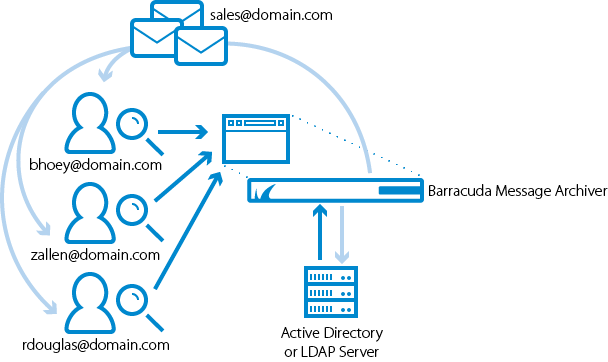This article refers to the Barracuda Message Archiver release 5.0 or higher.
Note that the Populate button is available on models 350 and higher.
Local Accounts
Create local users on the Users > User Add/Update page.
Group Membership
Archived messages that are sent to a mailing group are visible in the personal message archive for every member of that group. For example, if bhoey@domain.com , zallen@domain.com , and rdouglas@domain.com are all members of sales@company.com, then any message that is sent to sales@company.com is available in the archives of all three users.
Figure 1. Local Account Group Membership.

Alias Linking
You can create a local user account on the Barracuda Message Archiver with access to archived messages for multiple users. For example, you want a single user account to see emails for chris.smith@company.com , pat.jones@company.com , and alex.pierce@company.com , in addition to the_boss@company.com . To do so, create a local account on the Barracuda Message Archiver (for example, "local_boss"), and list as aliases the email addresses to which that account is to have access.
To list aliases for a new local account:
- Go to the USERS > User Add/Update page.
- Enter the new user Email Address, and specify whether the email is to be used as the account name.
- Next to Retrieve user Aliases from LDAP, click Populate; the User Aliases field populates with all user aliases associated from the LDAP for the specified email address.
- Click Save to save the list of aliases for that user. This account is added to the USERS > Accounts page including its aliases.
To list aliases for an existing local account:
- Go to the USERS > Accounts page.
- Click Edit for the primary user account; the USERS > User Add/Update page displays.
- Next to Retrieve user Aliases from LDAP, click Populate; the User Aliases field populates with all user aliases associated from the LDAP for the specified email address.
- Click Save to save the list of aliases for that user. The aliases are added to the Aliases field for this user in the USERS > Local Accounts page.
LDAP Accounts
Associated an LDAP user or LDAP group to a Barracuda Message Archiver role and list of email addresses on the USERS > LDAP User Add/Update page.
Discovery Option for Alias-Based Search
When conducting an Advanced Search, you can search on all aliases associated with an LDAP for a specified email address using "Discovery". This option searches for all items sent to or received by any email alias, address or account associated with specified email addresses, as resolved against the LDAP servers identified on the USERS > Directory Services page. The email address specified here is expanded to include all of the entries returned by LDAP, and each email address in the resulting list is searched for in the From, To, Cc and Bcc fields.
To search on all aliases associated with an LDAP:
- On the BASIC > Search > Advanced page, select All from the first drop-down menu, and select Discovery from the second drop-down menu.
- Select contains, and enter the user's email address.
- Click Search.
- To view all associated email addresses, click the Alias (
 ) icon to the right of your search criteria.
) icon to the right of your search criteria.
Group Membership
LDAP users often have one primary email address that is their user account name along with several aliases for convenience. For example, rdouglas@domain.com also receives messages as ryand@domain .com and ryan.douglas@domain .com. For organizations that use LDAP, messages sent to any alias are accessible from the primary user account.
Figure 2. LDAP Group Membership.

You can enter an LDAP group name in the LDAP User/Group field and select a role for that group. When a member of that group logs in to the Barracuda Message Archiver, they log in with the assigned role.
Include/Exclude Rules
You can define exclude/include rules on the USERS > LDAP User Add/Update page to set permissions on whose mail the LDAP user or group members can view. The addresses must belong to a user, group, or public folder on a configured LDAP server. When a configured user runs a search, the following rules are in place:
- Mail for addresses added to the Exclude these Addresses list are not displayed unless the mail includes the user performing the search to assure that a user can always see their own mail.
- The Exclude these Addresses list always takes precedence; addresses added to the Include these Addresses list are searchable unless the Exclude these Addresses list blocks the mail.
- Because a user with the Admin or Auditor role can by default view all mail, users set to these roles can only edit their Exclude these Addresses list.
- If a user is not configured and is a member of a group, then the include/exclude rules assigned to that group apply to that user. Additionally, if the unconfigured user is a member of multiple groups, then the privileges for all of those groups are merged and that user is assigned the least privileged role of those groups. This allows the Admin to apply include/exclude rules to all users of a distribution group.
- Example 1: If Zoe is not individually configured but is a member of the distribution group HR, then the Admin can set the include/exclude rules for the group HR, and Zoe uses these settings when searching mail rather than seeing only her own mail.
- Example 2: If Josh is not individually configured but is a member of the distribution group HR which has an Auditor role, and Josh is also a member of the group Employees which has a User role, Josh has only the User role privileges when running a search.
- A user cannot run a Search As User Search on the BASIC > Search page on a user that is on their Exclude these Addresses Exclusion Rules block list.
